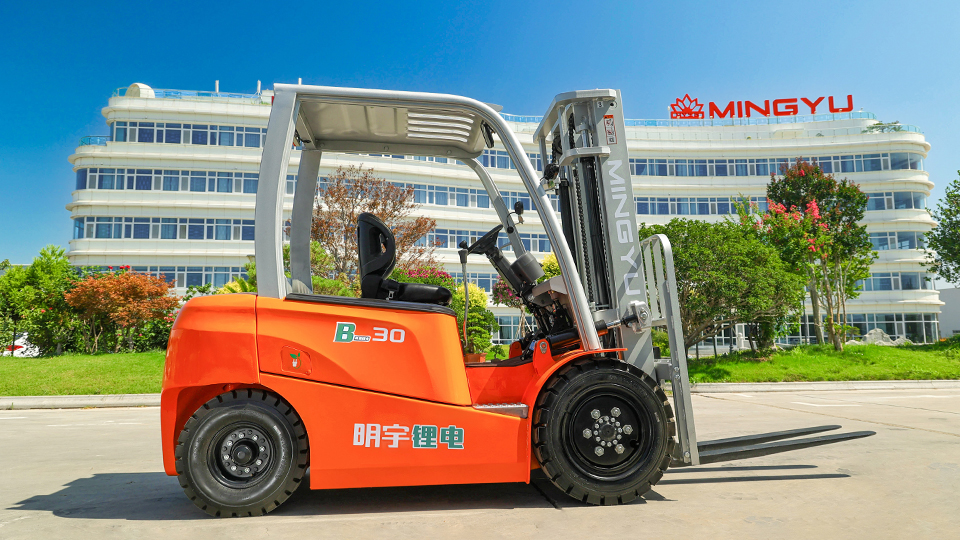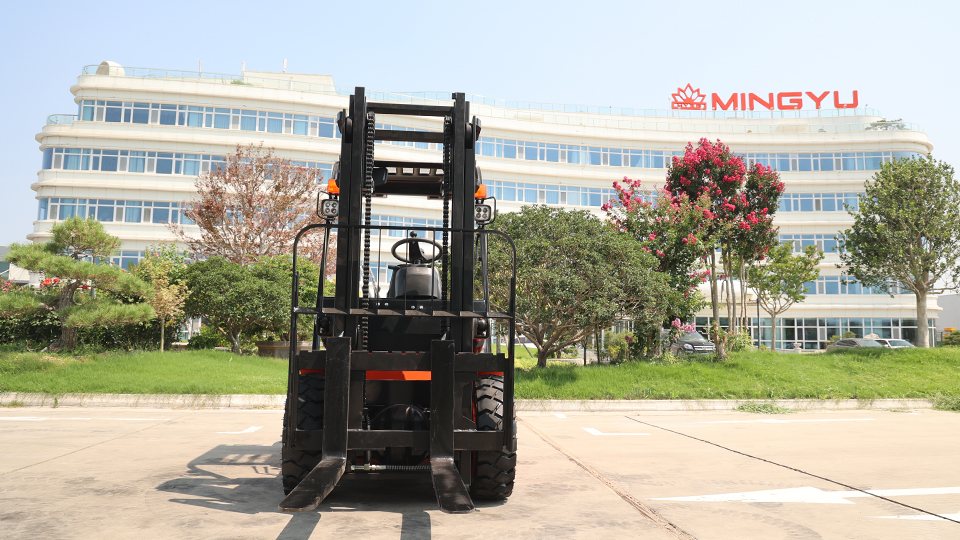
Safety and Operational Feasibility of Forklifts in Shipping ContainersThe ability to use a forklift within a shipping container is fundamentally determined by the container dimensions and the forklift specifications. Standard ISO (International Organization for Standardization) shipping containers typically come in lengths of 20 feet or 40 feet, and a standard width of 8 feet (2.44 meters) and height of 8 feet 6 inches (2.59 meters). High-cube containers offer an extra foot of height.1. Dimensional ConstraintsParameterStandard 20-Foot Container (Approximate Internal)Standard 40-Foot Container (Approximate Internal)Width7 ft 8 in (2.35 m)7 ft 8 in (2.35 m)Height7 ft 10 in (2.39 m)7 ft 10 in (2.39 m)Length19 ft 4 in (5.89 m)39 ft 5 in (12.01 m)Width is the most critical constraint.

The internal width of less than 8 feet necessitates the use of narrow-aisle forklifts or specialized compact models. Standard counterbalanced forklifts, especially those with large counterweights, overhead guards, or wide-set wheels, may struggle to maneuver or, in some cases, may not fit at all.2. Forklift Selection: Suitability and ModificationSelecting the correct forklift is paramount for safe and efficient container operation.A. Suitable Forklift TypesCompact Electric Forklifts (Counterbalanced): These are often the preferred choice due to their smaller footprint and zero emissions (critical for enclosed spaces). The capacity needed is usually small (1,000 kg to 2,500 kg), as the maximum load inside a container is often constrained by the container's floor rating and the desire to keep the forklift light.Reach Trucks and Pallet Jacks (Powered): While not traditional forklifts, powered pallet jacks are frequently used to move goods just inside the container door. Reach trucks are typically too large and designed for warehouse racking, not the confined floor space of a container.Low-Profile Forklifts: Some manufacturers offer models specifically designed with a lowered overhead guard or removable masts to fit the low door height and internal ceiling height.B. Dimensional ChecksThe following forklift dimensions must be checked against the container's internal space:Overall Width: Must be significantly less than the 7 ft 8 in internal container width to allow for steering and maneuvering clearance. A maximum width of around 5 feet (1.5 meters) is generally recommended.Mast Height (Lowered): Must be lower than the container door opening (approx. 7 ft 6 in or 2.34 m) and the internal ceiling height (approx. 7 ft 10 in or 2.39 m) to allow entry, exit, and safe operation.Turning Radius: The forklift must have a tight turning radius to be able to turn pallets or maneuver within the container's limited space, especially near the doors and in 20-foot containers.Safety Protocols and Hazard MitigationOperating heavy machinery in a confined, poorly lit space like a shipping container presents several unique safety challenges that require strict protocols.1. Ventilation and Fume Management ��This is arguably the most critical safety concern.Internal Combustion (IC) Forklifts (Propane, Diesel, Gasoline): Must be strictly avoided unless the container is parked in a wide-open area with a high-volume forced-air ventilation system.
Exhaust fumes contain carbon monoxide (CO), an odorless, colorless, and highly toxic gas that can cause incapacitation or death very quickly in a confined space.Electric Forklifts (Battery-Powered): Mandatory for container work. They produce zero operational emissions. However, the charging of batteries should never occur inside the container due to the risk of hydrogen gas buildup.Ventilation Procedure: Even with electric forklifts, the container doors should be fully opened and secured to maximize natural airflow and visibility. A secondary portable ventilation fan may be necessary to ensure fresh air circulation throughout the entire container, especially towards the back.2. Lighting and Visibility ��Shipping containers are dark internally, even with the doors open.Auxiliary Lighting: The forklift's headlights are often insufficient. External spotlights aimed into the container and portable, mounted LED work lights placed inside the container are essential for adequate illumination, especially near the roof and far end.High-Visibility Gear: Operators must wear high-visibility clothing (vests, jackets) to ensure they can be seen clearly against the container's dark interior.3. Stability, Floor Rating, and Loading/UnloadingA. Container Floor IntegrityThe floor of a standard shipping container is typically rated to withstand a maximum uniform floor load of around 5,460 kg per meter or a payload of up to 30,480 kg, depending on the container type. However, the point load exerted by the forklift's wheels, especially when loaded, can be very high.Maximum Forklift Weight: The combined weight of the forklift, the operator, and the load must not exceed the container floor's rated load, particularly the point load limits where the wheels rest. Using lighter, smaller forklifts helps mitigate this risk.Load Distribution: Pallets should be loaded so their weight is distributed evenly over the floor structure.B. Dock Plates and RampsThe height difference between the warehouse floor/dock and the container floor (known as the "step") requires a safe transition.

Required Equipment: A specialized dock plate or loading ramp with safety curbs must be used. This ramp must be rated for the maximum gross weight of the forklift and its load, and it must be secured firmly to prevent slipping or tipping during entry/exit.Angling: The ramp's angle should comply with safety standards (typically less than 10 degrees) to prevent the forklift from tipping backward when entering or forward when exiting.4. Operator Training and ProceduresSpecialized training is required for operating forklifts in confined spaces.Confined Space Awareness: Training should cover the unique hazards of limited visibility, tight maneuvers, and the dangers of carbon monoxide.Spotter Requirement: In many environments, a trained spotter or signal person should be used outside the container, especially during complex maneuvers or when reversing. The spotter ensures the safety of personnel outside the container and provides guidance to the operator, who has limited rearward visibility.Load Height: Loads must be kept low to maintain visibility and stability. The container ceiling is often the limiting factor for lift height, so mast extension must be strictly controlled to prevent damaging the container roof.
Regulatory Compliance and DocumentationCompliance with occupational safety and health regulations (like OSHA in the US or similar bodies globally) is mandatory.1. Equipment CertificationThe forklift used must be regularly inspected and certified. Any modifications (like a lowered overhead guard) must be approved and documented to ensure the equipment retains its safety rating and manufacturer specifications.2. Lockout/Tagout (LOTO)If the container is attached to a vehicle (truck chassis), the vehicle's engine should be turned off, and the trailer wheels should be chocked to prevent unexpected movement, a procedure often falling under LOTO or similar safe-working protocols. The container doors must be secured open to prevent accidental closure.3. Safety Data Sheets (SDS)If the goods being loaded or unloaded are hazardous materials (HAZMAT), the operator and spotter must be aware of the contents via the required Safety Data Sheets and follow all specific protocols for handling, ventilation, and emergency response.Alternatives to Driving Inside a ContainerIn many operational settings, the risks associated with driving a forklift completely inside a container outweigh the benefits. Alternatives are often preferred for safety and efficiency.1. Reach-In/Loading EquipmentForklift Attachments: Specialized extending fork attachments or telescopic booms can allow the forklift to remain outside the container while placing loads far inside.Container Stuffing Equipment: Purpose-built equipment, such as conveyor systems or powered floor loaders, can slide or roll cargo directly into the container from the dock without requiring a forklift to enter.Powered Pallet Jacks/Walkie Stackers: These are ideal for moving individual pallets or slip sheets to a point just inside the container door where a larger forklift can pick them up (when unloading) or drop them off (when loading).
They are smaller and offer superior maneuverability.2. Slip Sheets vs. PalletsLoading goods on slip sheets instead of traditional wooden pallets allows for greater flexibility. Slip sheets are thinner and often handled using a push-pull attachment on the forklift, which means the forklift doesn't need the clearance for pallet entry and exit, potentially allowing for a slightly smaller truck or faster loading/unloading by external equipment.ConclusionThe question, "Can you drive a forklift in a shipping container?" is answered with a qualified yes, but only under a strict set of conditions and protocols. It is not an operation to be taken lightly.Success depends critically on selecting a suitably sized electric forklift, ensuring excellent ventilation to eliminate the risk of carbon monoxide poisoning, securing the container with proper dock plates and wheel chocks, and utilizing well-trained personnel with adequate lighting and a spotter. While feasible, the trend in modern logistics is moving toward specialized loading equipment and non-IC forklifts to mitigate the significant inherent risks of working in a confined space. Safety and compliance must always override operational speed. The risks of a confined-space accident, equipment damage, or personal injury are high, necessitating a conservative and highly regimented approach to this common yet challenging task.
Name: selena
Mobile:+86-13176910558
Tel:+86-0535-2090977
Whatsapp:8613181602336
Email:vip@mingyuforklift.com
Add:Xiaqiu Town, Laizhou, Yantai City, Shandong Province, China